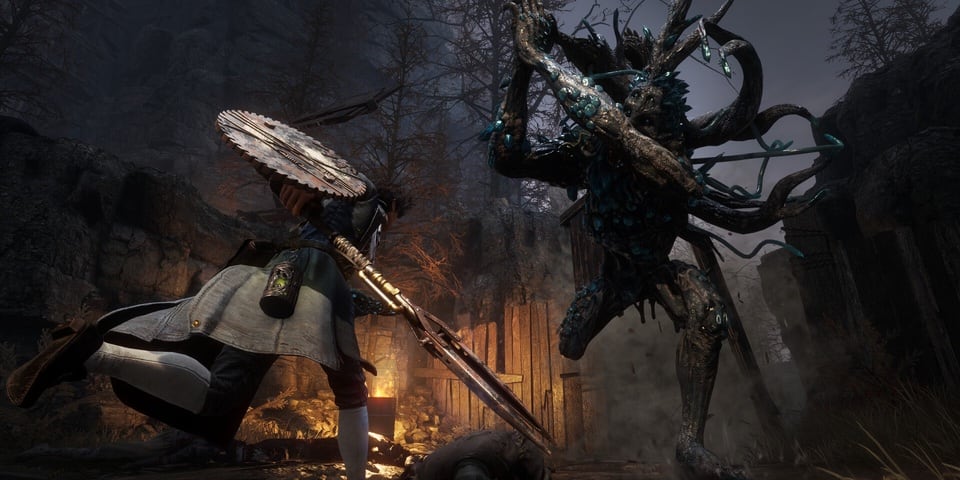Set in the aftermath of all the puppets in the Victorian era city of Krat going into a murderous frenzy, it’s immediately clear that Lies of P is not your grandaddy’s Pinocchio story. Opening in a train carriage with Pinocchio having been brought to the city, you’re led by Sophia the blue butterfly and Gemini the ethereal entity on a journey into this deadly city to search for your owner/father Geppetto and to uncover the mystery behind the events of the Puppet Frenzy.
As with most Soulslikes, you’ll be tentatively exploring the world and battling enemies that you encounter, searching for shortcuts on the route to bosses, and trying to absorb the world’s story along the way. Once you reach it, the hotel acts as a central hub, home to various survivors and other inhabitants that let you level up, shop and upgrade your equipment. You can also build new weapons by combining different handles and blades to find your ideal playstyle, which I have found to be a blade with fire damage and a longer handle for reach, but there’s no penalty for experimenting, so you might as well give things a try.
Nestled in your interactions with the NPCs is a fun little mechanic that can change how your conversations might go. Certain encounters give you the option to answer a key question with the truth or a lie, the correct answer will endear the character to Pinocchio and the wrong will end with a new enemy that you may have to fight immediately. Unlike the classic wooden puppet through, it’s often the better option to lie, and you don’t even have a longer nose to worry about.

While wandering the world, you will find odd devices called Stargazers, which act as checkpoints that you will return to upon death and can be rested at to restore Pinocchio to full health and resources. You can teleport between all active Stargazers, and switch out pieces of gear while resting, if you find a better set is suited to the area ahead. There is a cost to using these devices, however, they will restore most enemies in the area – outside of special encounters of course. They’re this game’s equivalent to Dark Souls’ bonfires.
Of course, much of the game is spent relentlessly beating up puppets or having them do the same to you. The basic controls simple; you have a light attack, heavy attack, dodge, block and parry. This will see a dance of sorts as you dash in to deal damage against the puppets and dash out again to avoid their erratic movement and powerful strikes. This basic system is well-balanced and provides an excellent flow to the gameplay loop, which is pushed to even greater heights by the Legion weapons.
One big difference between the Disney version of Pinocchio we know and love and this coiffed badass is that he can replace his left arm with different Legion Arms that provide different abilities or benefits. These include the Puppet’s String, which act as a chain to pull in enemies to you or vice versa, and the Fulminis, which sends out a potent electric shock. These Arms, after a certain point in the story can be upgraded to further expand your move set or increase their potency.

The thing to keep an eye on whilst tearing foes apart is the Legion meter that will dictate how much you can use the Arms without resting at a Stargazer or using a Legion Magazine to refill the meter. This then adds to the patience needed in this combat system as you might be better letting the enemy exhaust their combo and dashing in with regular attacks than using the Legion gauge to pull them towards you. This being said, the Fulminis is always a good shout as the electric damage isn’t to be scoffed at.
Rounding out the array of combat options are the Fables and critical attacks. Fables are weapon-specific skills that allow access to additional abilities such as powerful parries or high-damage combo attacks, which are fun to experiment with. Critical attacks can either be executed by attacking an enemy from behind, at which point claw marks will appear indicating you can essentially impale them. The other method is to damage the enemy enough for their life bar to flash, at which point landing a fully charged heavy attack will stagger the enemy for a critical attack.
As you’re guaranteed to take damage as some point, you have a set of Pulse Cells, healing potions that are restored at Stargazers. One little thing I want to point out about these is that if you run out, you can restore one charge by landing enough attacks on enemies without dying. It’s an excellent one last chance mechanic and really ramps up the tension as you’re desperately trying to build up a charge to stave off death for just a little longer.
In short, the key strategy with combat in Lies of P is in pattern recognition and patience. Tackling this game thinking you will be able to react to the enemy attacks often won’t work in your favour, as a lot of attacks have practically non-existent wind-up animations. As such, if you have come here from similar games, you might find that it takes some time to find the groove of exactly how this game wants you to play. This point will most likely be the first boss encounter.

Lies of P is punctuated by its major boss battles. They’re placed at the end of each area as a final test of sorts, with smaller mini bosses littered throughout, usually as optional encounters off the main path. These are huge automatons or creatures with huge health bars and colossal damage outputs, and while they are excellent encounters and tests of skill, there’s a huge gulf between them and the rank and file leading to rather spiky difficulty levels – something that isn’t uncommon for this genre, and honestly part of the masochistic appeal. Bosses take the core combat flow to the logical end point, with minimal wind-up animations and intense focus on watching the bosses to work out the best times to strike or hang back.
The world and the characters of Krat are stunning, or as stunning as a city ruined by murderous puppets and strewn with dead human bodies can be. The art style throughout is just distinct enough from realism to avoid the uncanny valley effect that human characters sometimes have, contributing towards the overall steampunk dark fantasy aesthetic. This is reflected in the sound design too, with stark mechanical clanks and visceral screeches punctuating the atmospheric sound of distant barking dogs and the orchestral scores of the boss encounters.



